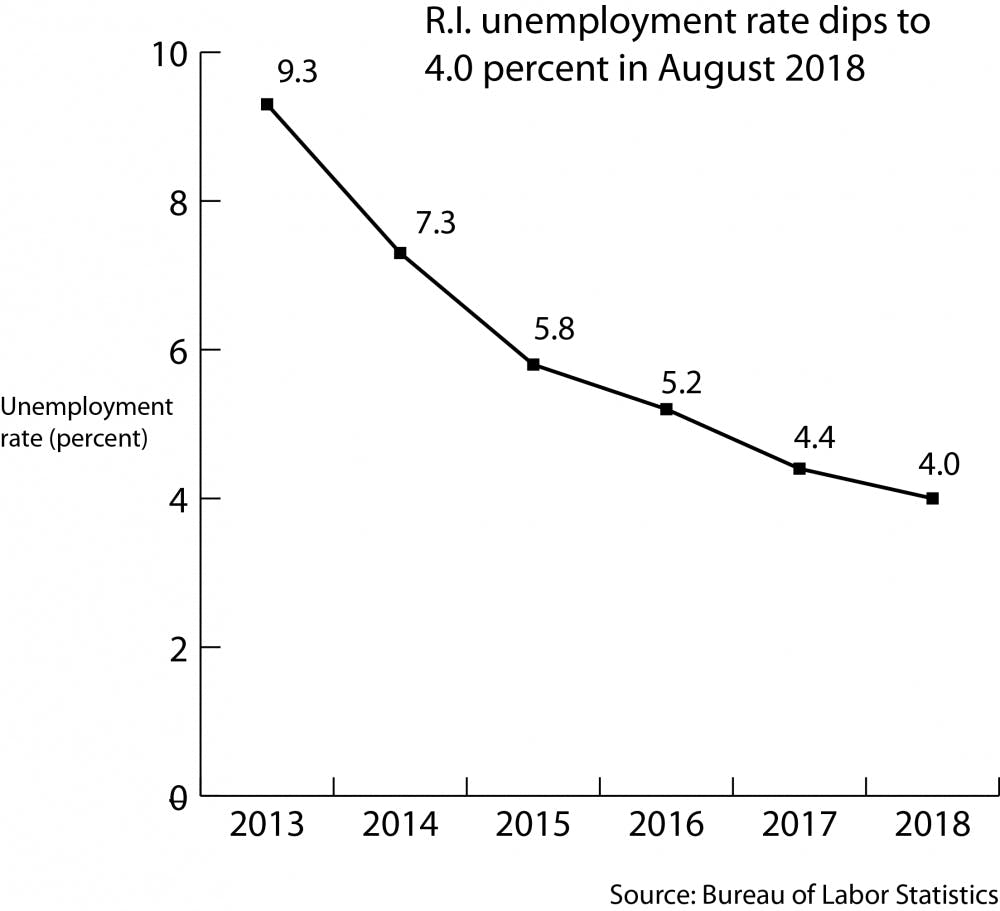The Rhode Island unemployment rate is down to 4 percent for the month of August and closely trails the national August rate of 3.9 percent, according to a recent report released by the R.I. Department of Labor and Training. There are 8,900 more employed residents than there were exactly a year ago.
“It’s been significant progress recently to come down and be right on level with the national unemployment rate,” said Nora Crowley, chief public affairs officer for the R.I. Department of Labor and Training. She added that the R.I. unemployment rate is currently the lowest it has been in 20 years.
The Great Recession in the late 2000s left Rhode Island with one of the highest unemployment rates in the country. The state had the nation’s highest unemployment rate of 9.3 percent in 2013, but it has since improved to 30th, according to the R.I. Department of Labor and Training. This trend should continue to improve in the coming months, Crowley said.
The department pays particular attention to middle-waged industries — which are in sectors such as manufacturing and construction — because these fields provide opportunities for middle-class families. Through efforts such as the business-led partnership program Real Jobs Rhode Island, which connects employers to potential employees and provides training programs, the state has invested in these sectors because they have been slow to recover from the recession, Crowley said.
In the past year, the state added 1,800 jobs in the Professional and Business sector, 400 in the Financial Services sector and 1,500 in Health Care and Social Assistance.
Real Jobs Rhode Island plans to go further in developing “robust industries” such as technology and hopes to double its training efforts in those fields. The program surpassed its projected annual target of placing 3,500 trained employees by 200 as of Sept. 1, Crowley said.
“A thriving economy in Providence and in Rhode Island is certainly good for the greater community and the state’s residents,” wrote Director of News and Editorial Development Brian Clark in an email to The Herald.
But CEO of Rhode Island Center for Freedom and Prosperity Mike Stenhouse believes that a downward trend in unemployment in the state still does not provide a full picture of Rhode Island’s economic climate.
“A lot of people check in the box that they worked a few hours,” Stenhouse said. “But if you really look at whether or not they’re prosperous, the answer is no.”
While the state does offer lower-paying jobs, its high-tax and regulatory policies continue to drive away business owners and further investments in high-end industries, Stenhouse said. “Compared to the money people are making and … the taxes they are paying, it is not a good environment for a business to be established and grow.”
For Brown students, these job prospects may push them toward moving elsewhere after graduation.
In his job search, Kevin Argueta ’17.5 found that Rhode Island’s highest paying jobs are predominately in software and not in engineering, his intended field. The engineering firms he encountered were focused on expanding outside of the state. Argueta, a R.I. native, relocated to Virginia to pursue a job offering in electrical engineering.
Senior Ryan Miller ’19, a double concentrator in architectural studies and urban studies, is also looking beyond Rhode Island for employment.“While I know of some very interesting smaller architectural firms in Providence, I don’t have the impression that it’s a huge field in Rhode Island,” Miller said. “I think that the specialties that I’m interested in related to design are more likely to be active in larger cities than Providence.”





